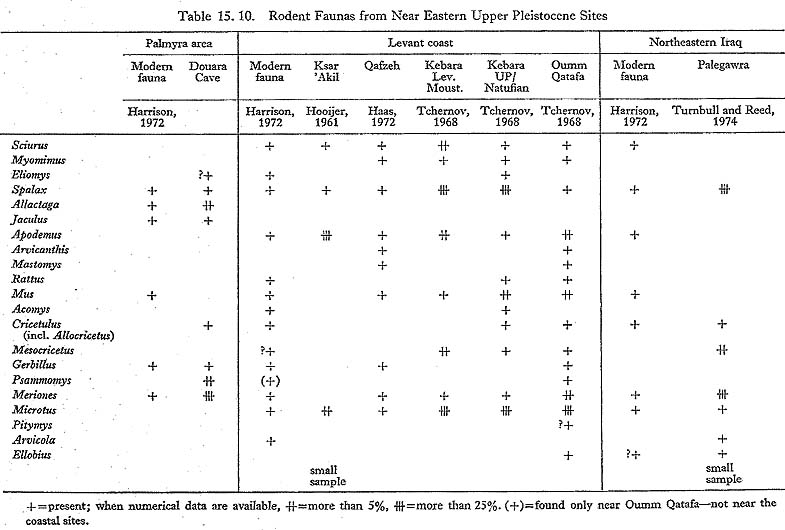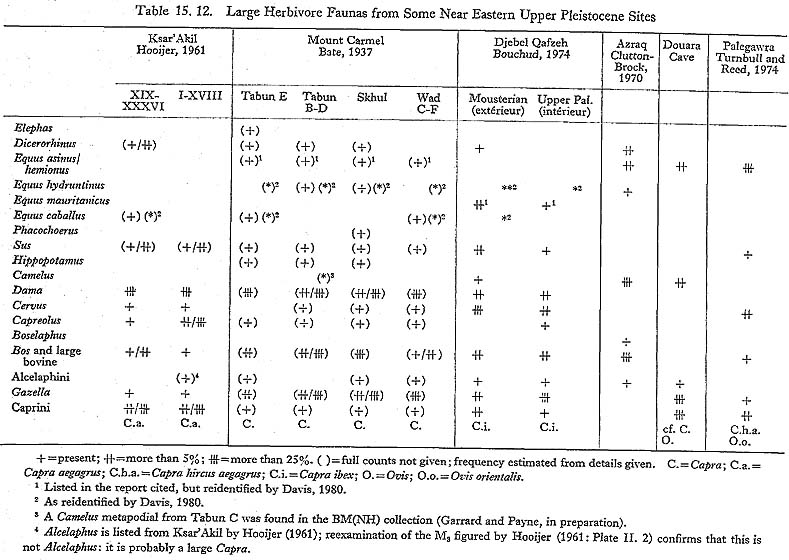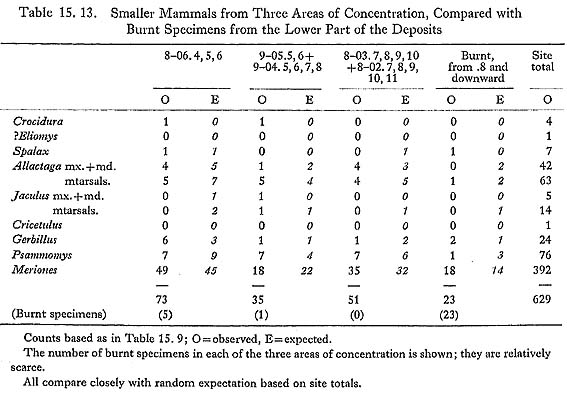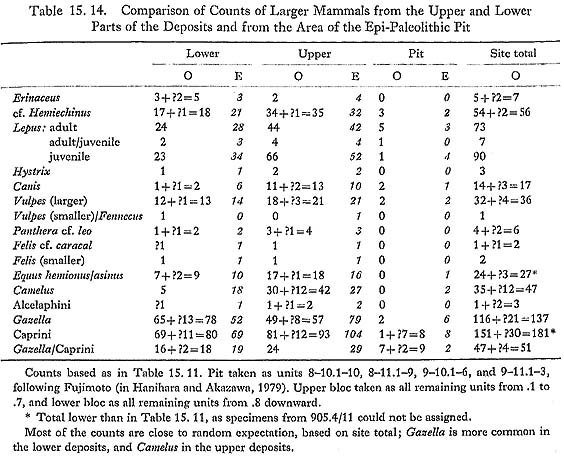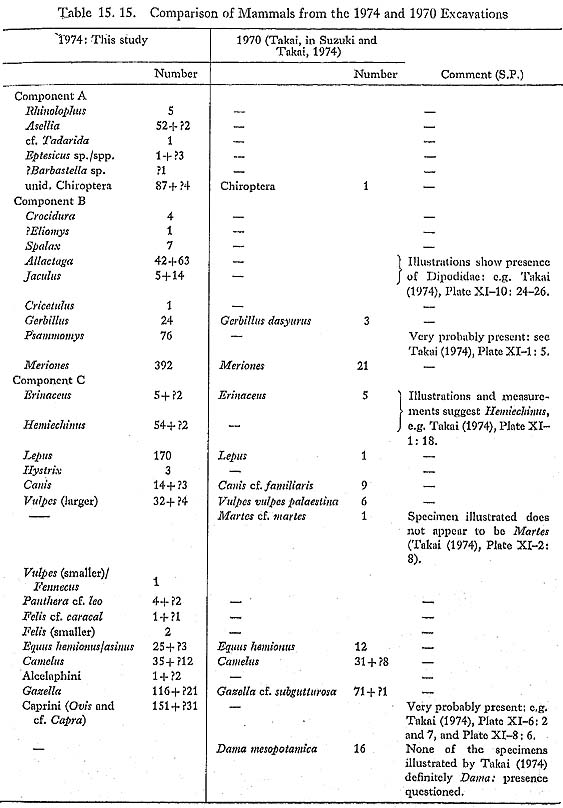CHAPTER 15
The Animal Bones from the 1974 Excavations at Douara Cave
Sebastian Payne
Trinity Collage, University of Cambridge
| ( 8 / 10 ) |
15. 3. 3 Environmental reconstructionIn the following discussion, the mammal bones from the 1974 excavations at Douara Cave are treated as a single assemblage, despite the recognition by the excavators of four major atratigraphic units, three of which were further subdivided. There is in fact little bone from Horizons I and II; the bone assemblage is effectively from Horizons III and IV (both Middle Paleolithic), and, as discussed below (p. 91), differences between the two are slight, and similar conditions are indicated. As most of the squares were excavated by measured units, and these frequently cross-cut stratigraphic boundaries, any elimination of such units would result in small samples from any single stratigraphic unit. 15. 3. 3. 1 Component A: bats Bats are of limited value as environmental indicators; they are very mobile, and most species are tolerant of a relatively wide range of conditions. The Douara Cave assemblage (Table 15. 8) is dominated by Asellia, a colonial bat which is widely distributed over the Near East, but which neither extends into the driest desert areas nor northward into the Boreal Eurasiatic zone. The remaining genera are fairly widespread. Two of the bats represented are apparently outside their modern ranges, but both are only tentatively identified from single specimens. Tadarida species with two lower incisors (e.g. T. [Mops] midas, T. aegyptiaca and T, [Chaerephon] pumila) now occur well to the south of Palmyra, in Egypt and in southern Arabia; and of the two Near Eastern species of Barbastella, B, barbastellus is a Boreal Eurasiatic species, occurring only well to the north of Syria, while B. leucomelas is recorded only from Sinai and Eritrea (Harrison, 1964). All that can really be said from the bats is that the dominance of Asellia probably indicates fairly dry but not extremely dry conditions. 15.3.3.2 Component B: small mammals As discussed above (pp. 62 et seq.), the small mammal assemblage is taken to have been brought to the cave by owls, and thus can be taken to reflect conditions within a radius of 1-3 km around the cave. Today this area is open and sparsely vegetated; most of the area is takn up by terraces and sloping pediments with fairly stony surfaces, lying against the limestone cliffs and talus slopes of the Jabal ad Douara, and cut by steep-sided wadis. The small mammal assemblage (Table 15, 9) is dominated by gerbilline rodents (Gerbillus, Meriones and psammomys) and jerboas (Allactaga and Jaculus), and matches the modern rodent fauna fairly closely. Only Mus is present in the modern fauna and absent from the cave assemblage; Psammomys, Eliomys (?) and Cricetulus are present in the cave assemblage and not reported today, but the modern fauna of the Palmyra area is inadequately known. Psammomys in particular seems quite likely to be found: it is known from El Karyatein (Harrison, 1972), which is only about 100 km WSW of Palmyra, and its distribution tends to be patchy, so that small colonies might easily be overlooked. The presence of both Allactaga and Jaculus is interesting: both occur today in the Palmyra area, but Jaculus is close to its northern limit. Harrison (1972: 412) comments that Allactaga is normally rarer than Jaculus when both are found together; but the reverse is true of the Douara Cave sample, which may indicate a shortage of softer, sandier terrain around the cave. The environmental and climatic conditions indicated by the Douara Cave rodent fauna seem, overall, to be strikingly similar to conditions today. Gerbillus would be at home, especially on the rocky talus slopes; Meriones and Allactaga on the terraces and pediments; and Psammomys in patches of succulent Chenopodiaceae. The area cannot have been much drier than today, or Spalax would be excluded: the 100mm isohyet is an effective limit in Israel (Nevo, 1961); the relatively small size of the Douara Cave Spalax suggests that it was close to the arid limit. Furthermore, rainfall cannot have been much higher, for if it were, we would expect to find Mesocricetus; Microtus, if there was more permanent water; and Mus and Apodemus, if there was more cover. A comparison with other Near Eastern Upper Pleistocene rodent faunas emphasizes the semi-desert character of the Douara Cave fauna (Table 15. 10). The rodent fauna from Palegawra (Turnbull and Reed, 1974), in northeastern Iraq, is dominated by Spalax and Meriones, with some Mesocricetus; scarcer species include Microtus and the water-loving Arvicola. Damper conditions there than at Douara Cave seem clearly indicated, though without very much cover. The rodent fauna from the Judean Desert site of Oumm Qatafa (Tchernov, 1968) is dominated by Apodemus, Mus, Microtus and Meriones, together with a wide range of scarcer species; but there are no jerboas. Damper conditions and some scrub or tree cover are indicated; diversity of conditions is also suggested by the much larger number of rodent genera and species represented in the Oumm Qatafa fauna. Sites closer to the Mediterranean coast and further to the north, such as Kebara (Tchernov, 1968) and Qafzeh (Haas, 1972) give similar and even damper indications: Apodemus, Mus, Spalax and Microtus are generally common, and the range of rodent genera represented is similar to that at Oumm Qatafa.
15.3.3.3 Component C: larger mammals The larger mammal remains from Douara Cave are taken to be mostly human food remains and thus to reflect conditions over a wider radius than the remains of rodents. A wider radius around the cave (Fig. 15. 1) brings in areas of steep and rocky terrain to the north and west of the cave, and large areas of gentle slopes to the south. Counts for the larger mammals are given in Table 15. 11. As this table shows, the sample is dominated by Gazella and Caprini (probably including both Ovis and Capra in similar amounts); Lepus, Hemiechinus, Vulpes,. Camelus and Equus are all fairly common. The herbivores clearly indicate open and dry conditions: the steep and rocky areas to the north would provide terrain suitable for Capra, and the gentle slopes to the south would provide terrain for Equus and Camelus, with Ovis and Gazella probably in both areas, but avoiding the roughest patches. A vegetation dominated, as today, by Gramineae, Chenopodiaceae and Compositae, such as Artemisia, would provide adequate grazing for the animals represented, all of which are able to tolerate drought and poor sparse grazing. The absence of such genera as Bos, Sus, Cervus, Dama and Capreolus is significant: Bos would suggest rather richer grazing, while the other genera need more cover and water. Of the other larger mammals, some, such as Hemiechinus, Felis caracal and Fennecus/Vulpes rüppelli, again suggest open and dry conditions. Others, such as Lepus and Vulpes vulpes, are tolerant of a wide range of conditions: they would be at home in the dry conditions suggested, but would also be found in much damper conditions-though the size of the Vulpes specimens would again be typical of drier rather than wetter conditions. Only Erinaceus among the mammals present at Douara Cave suggests slightly different conditions than are found today; it is not reported from the Palmyra area today and is found only in areas nearer the Levant Coast with higher rainfall and more cover, though stragglers have been found in Israel as far south as the Gaza area (Harrison, 1964). As with the rodents, comparison of the larger herbivore component of the Douara Cave fauna with that from other Near Eastern Upper Pleistocene sites (Table 15. 12) again suggests conditions that were considerably drier around Douara Cave than around the other sites. Mount Carmel, Ksar'Akil and Qafzeh, all three of which are close to the Mediterranean and have substantially more rainfall today than in the Palmyra area, also all have faunas that imply relatively high rainfall and large areas of tree or scrub cover, with an abundance of animals such as Dama and Bos and the presence of Capreohis, Sus and Hippopotamus. Azraq, in a much drier area today than the coastal sites, has a much drier fauna, dominated by Camelus and lacking cervids and Sus; the absence of Gazella and of any other smaller species is startling and suggests very strong sample bias; the abundance of the large bovine suggests better grazing than around Douara. Palegawra again has a fairly "dry" fauna, but the presence of Bos and the abundance of Cervus suggest damper conditions and better grazing than around Douara, as the rodent fauna confirms.
15. 3. 3. 4 Homogeneity of the faunal sample Up to this point, the faunal sample from the 1974 excavations at Douara Cave has been taken as a single assemblage, despite the recognition by the excavators of four distinct major stratigraphic units (Horizons), three of which were further subdivided, For reasons discussed above (p. 85), precise stratigraphic subdivision of the faunal samples presents problems; but in order to test whether there is any indication of environmental or climatic change within the excavated sequence, the faunal samples can be grouped into large blocs that correspond, approximately with main stratigraphic units. Also, the distributions within the deposits of species with differing environmental implications can be compared. In each case, comparisons between species that owe their presence in the cave to different agencies may be misleading, and it is preferable to consider each component of the faunal sample separately. The bat bones are of little assistance: not only are they of limited use as environmental indicators but also the main concentration of bat bones (Fig. 15. 56) falls in Horizon IVB, and there is little from the other Horizons with which to compare it. The main concentrations of rodent bones fall within or close to Horizon IIIB (Figs. 15. 4 and 45). Not all the rodent bones are from this Horizon, however: most of the rodent bones from the lower hearth deposits (Horizon IVB) are burnt, and thus clearly not intrusive from above, where nearly all the rodent bones are unburnt. If the rodent bones from the main concentrations are compared with the burnt rodent bones from the lower deposits, there is no suggestion of any important difference: counts do not differ significantly from random expectation (Table 15. 13).
The larger mammals show no very clear differences when the distributions in Figs. 15. 41-44, 52 and 54 are compared. If a rough division is drawn between the upper and lower parts of the deposit (Table 15. 14), relatively little difference is seen between the two blocs, except that Gazella is more abundant than random expectation in the lower bloc, and Camelus is more abundant in the upper bloc. There is, therefore, every indication that environmental conditions were similar in Horizons III and IV. Horizon II (the Epi-Paleolithic pit; Table 15. 14) and Horizon I are relatively poor in bone; counts for the units that correspond roughly with the pit show nothing remarkable except for the higher proportion of bones in poor condition, identified only with reserve. Middle Paleolithic flints were mixed with the Epi-Paleolithic industry in the pit, and some of the bones from the pit may be residual Middle Paleolithic material: a lower first molar of Canis (810.10D-1), for instance, fits into a mandible found in square 9-06, some distance from the pit, and another part of the same mandible was found in square 8-09 (p. 42).
15. 3. 3. 5 Environmental conditions during the Middle Paleolithic occupation: comparison with other sources of evidence As detailed above, each of the three components of the Douara Cave mammal fauna gives similar environmental indications for the Middle Paleolithic occupations of Horizons III and IV. The rodent fauna suggests an annual rainfall equivalent to 100-150 mm under modern temperatures (i.e. less if colder, more if warmer) and a strong summer drought; the mammal fauna as a whole is dominated by desert-adapted animals, such as gerbilline rodents, jerboas, camel and gazelle, and lacks the more mesic species characteristic of the wetter coastal sites, such as Bos, Sus, cervids and murine and microtine rodents. The presence of Erinaceus and Spalax in small quantities suggests that conditions cannot have been drier, and that there may have been rather more plant and shrub cover than there is today; but there would certainly be considerably more plant cover today if grazing pressure were reduced; the modern denuded landscape of the area is the result of millennia of abuse, of overstocking with domestic animals and the destruction of trees and bushes for fuel. An arid steppe vegetation is suggested, dominated by Gramineae, Chenopodiaceae and Artemisia, with patches of scrub and occasional trees in places where run-off collected and soils were deeper. This reconstruction differs substantially from those put forward previously. There is undoubted evidence for wetter and/or cooler conditions at some time in the past, as shown by Sakaguchi in his study of the Palmyra Basin. pluvial lake (in Hanihara and Sakaguchi, 1978), but it is difficult to establish the exact chronological relationship between the lake and the Middle Paleolithic occupations of the cave, as precise dating is lacking. Dates for the Middle Paleolithic occupations of the cave (p. 5) lie beyond the effective radiocarbon range, and the available radiocarbon, fission-track and racemization determinations range from 38,900 y.B.P. to 110,000 y.B.P.; dates for the lake (p. 10) again cover a wide span, from two radiocarbon dates around 19,000 BP to a fission-track date of 70,000 y.B.P. Evidence from the cave itself is provided by pollen and other plant remains, and by the animal bones. Sohma and Sasaki (in Suzuld and Takai, 1973: 133-141) concluded that the climate was cooler and more humid than today, but their pollen samples from the cave deposits were very poor: over 20 samples were taken from levels C to N, and none produced more than 9 pollen grains. Their conclusion was based mainly on the absence of Chenopodiaceae and Compositae (dominant in modern samples) from their samples from levels K and F and from 1 sample from level E, together with the presence of Juniperus. But the number of pollen grains in these samples is very small: the 3 samples from levels K and F contained a total of 5 pollen grains, 2 of which were Juniperus, and these levels are below the Middle Paleolithic occupation excavated in 1974 (Horizons III and IV of 1974 are equivalent to levels C to E of 1970). Pollen samples from the Middle Paleolithic occupation itself (10 samples from levels C to E) contained a total of 15 pollen grains, 7 of which are Chenopodiaceae, 1 Artemisia, 1 Gramineae, 1 Pistacia, 1 Pinus, 2 Juniperus, and 2 unidentified (Sohma and Sasaki, 1973: Table IX-1). Matsutani (in Hanihara and Akazawa, 1979: 225-233) describes charcoal fragments that "are possibly stems of Chenopodium" in Horizon I, and the frequent occurrence, particularly in Horizon IVB, of amorphous silica fragments "whose microscopic structure resembles spodograms of seeds of some Boraginaceae." Finally, Takai (in Suzuki and Takai, 1974: 169-181), reporting on the faunal remains from the 1970 excavations, suggested that conditions during levels C to E (equivalent to Horizons III and IV of 1974) were somewhat damper and cooler, proposing the correlation of these levels with "a little humid phase that preceded the Göttweiger interstadial." His results differ substantially from those reported here: in particular a number of specimens of Dama are identified, and no mention is made of Caprini (the cominonest large mammal category in the 1974 sample). The identification of specimens from photographs is undoubtedly hazardous (even when they are good photographs, as these are), and I have been unable to examine the specimens themselves; nonetheless, it must be said that the identifications of some of the illustrated specimens seem improbable. Thus what are probably caprine specimens have been identified as Dama (e.g. Plate XI-6:2 and 7) and as Gazella (e.g. Plate XI-8: 6), and none of the illustrated Dama specimens is entirely convincing. The canine illustrated as Martes (Plate XI-2: 8) does not appear to be Martes, and the illustrations include what seem to be fairly definite specimens of Psammomys (plate XI-1: 5, identified as Meriones) and of jerboas (Plate XI-10: 24-26, identified as being from an unidentified bird), neither of which appears in his list. If these suggestions are correct, and if there are no specimens of Martes or of Dama in the collection, the sample looks very much more like the 1974 sample, and there is nothing to suggest (as Dama would) substantially damper or cooler conditions (Table 15. 15).
In conclusion, while the high stand (or stands) of the pluvial lake shows that conditions were cooler or wetter at some time in the past, the direct evidence of the animal bones from the Middle Paleolithic occupations of Horizons III and IV provides strong evidence for a climate as dry as prevails today, but with rather more plant cover. The scanty plant remains from these levels are not in conflict with this suggestion: Boraginaceae would be common in such a setting, as would the Chenopodiaceae, which make up the commonest element in the scanty pollen samples. The grains of Pinns, Pistacia and Juniperus may be wind-transported (the prevailing wind today is from the west), or these genera may have been components of the local scrub patches. Conditions in levels K and F might, as Sohma and Sasaki suggest, have been cooler and damper (though any conclusion based on 5 pollen grains must be very tentative), but these levels are earlier than the Middle Paleolithic oc cupations and the bone samples that are the subject of this report. Whether the high lake stand (or stands) corresponds with these earlier levels, or is earlier or later, cannot be established without better dating evidence; but what does seem clear is that the dry con ditions indicated by the faunal samples from the Middle Paleolithic occupation levels are not compatible with the conditions required for a high stand of the pluvial lake, and that the lake was not contemporary with the Middle Paleolithic occupations. 15. 3. 3. 6 The regional climatic sequence and its zoogeographical implications Two opposing views have been advanced of climatic change in the Near East during the Upper Pleistocene. The traditional view, based on evidence such as Bate's Gasellaj Dama graph from the Mount Carmel sites (Bate, 1937: Fig. 1), is that the sequence is characterized by fluctuation between wetter and drier periods in much the same way that the contemporary European sequence is marked by fluctuation between colder and warmer periods. The nature of the relationship between the two sequences has been the subject of much debate. More recently, Tchernov (1968, 1975) has interpreted the sequence as showing a progressive desiccation throughout the Upper Pleistocene, without fluctuations: "The fauna . . . displays no correlative-or indeed any-fluctuation along the entire Upper Pleistocene" (1968: 7); "... a clear trend, which points to a desiccation process, proceeding from south to north. . . . The desiccation process may be swifter in a period of increasing warmth . . . and slower during a cooling-off period . . ." (1968: 133). The faunal evidence from Douara Cave, suggesting as it does conditions as dry as today in the Palmyra area over 40,000 years ago, is hardly compatible with Tchernov's interpretation: the Douara Cave mammal fauna is strikingly like the modern fauna of the area (especially once allowance has been made for recent overgrazing, overhunting, and habitat degradation), and the genera that would be expected if conditions had been substantially wetter, such as Microtus, Apodemiis, Bos, Sus and Damn and other cervids, are absent. The main problem in trying to reconstruct a sequence for the Upper Pleistocene, and in trying to place Douara Cave and the other evidence from the Palmyra Basin within such a sequence, is that no very reliable dating method is available beyond the effective range (30,000 to 40,000 years) of present radiocarbon dating. The whole of the long Middle Paleolithic sequence lies beyond this range, and attempts at correlation between Middle Paleolithic sites are fraught with uncertainty. Sites with long sequences, such as Tabun and Ksar'Akil, have been used as the basis for attempts at correlation, but it is difficult to know how much of the sequence is present at any site, and it seems likely that none of the sites offers us more than parts of a full sequence, often with possible internal gaps. At Douara Cave, for instance, there may be a substantial time gap between Horizons III and IV, as Akazawa (Hanihara and Akazawa, 1979: 2) has suggested; and though Horizons III and IV give similar environmental indications, they may be separated by a wetter or drier episode of considerable duration. The lithic industries of Horizons III and IV provide little basis for correlation with other sites, and therefore, in view of all the uncertainties involved, it seems unprofitable to attempt a detailed correlation between Douara Cave and the Levant coast sites. What can be said is that the Middle Paleolithic occupations at Douara Cave took place during a period or periods of climatic conditions not very different from today, and that it is likely that they will correlate with periods at the coastal sites that also suggest conditions similar to local conditions today; but there may have been several such periods during the Middle Paleolithic sequence. Zoogeographically, the chief interest of the Douara Cave fauna is its clearly Saharo-Sindian character. Today, Douara Cave lies within the Saharo-Sindian zone, but close to its northern border (Fig. 15.6; Harrison, 1964: 4-5). Virtually all of the mammalian genera identified among the Douara Cave animal bones are found today within the Saharo-Sindian zone, and some, such as Asellia, Psammomys and Jacuhis, are restricted to this zone. The one exception is the Boreal Eurasiatic Erinaceus,4 but other representatives from this zone are absent: Spalax and Eliomys are largely Boreal Eurasiatic, but have well-established populations within the Saharo-Sindian zone. The only suggestion of a Tropical Ethiopian element is the Tadarida; of the Near Eastern species with two lower incisors, T. pumila and T. midas are Tropical Ethiopian, while T. aegyptiaca is widely dis tributed throughout Africa, as far north as Egypt, and eastward as far as western India. The close similarity between the Douara Cave fauna and the present-day fauna of the Palmyra area is striking, and suggests that this fauna is long established and long adapted to the semi-arid conditions of this area. Fossil records and modern distributions suggest that the Near Eastern semi-arid zone must on occasion have contracted or shifted substantially, allowing, for instance, Microtus to reach Libya; but the close similarity of the Douara Cave fauna to the present-day fauna of this zone suggests that the Near Eastern semi-arid zone never disappeared completely during the Upper Pleistocene. |
|
4 There are also sub-Saharan species of Ennaceus, but it seems very much less likely that one of these is present at Douara Cave rather than one of the Boreal Eurasiatic species, such as E. concolor.[return to the text] |
